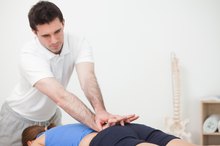How Does Exercise Improve Your Posture?
Maintaining proper posture elongates your torso and creates a long, lean profile, which makes you look taller and thinner. Beyond the cosmetic, proper posture also supports the spine and helps prevent conditions such as sciatica and herniated disks, which can cause back pain. Regular exercise can actually improve your posture in several ways.
Strengthening the Core
The core muscles include the abdominal group and the lower back muscles, as well as the thighs and buttocks. The abs and lower back stabilize the lower torso to keep the spine upright, while the thighs and buttocks help keep the hips in proper alignment. Core-specific exercises, such as Pilates and yoga poses, condition these muscles, as do leg-specific resistance exercises, such as squats and lunges. Try increasing your time holding plank exercise for a killer core and strong back.
- The core muscles include the abdominal group and the lower back muscles, as well as the thighs and buttocks.
- The abs and lower back stabilize the lower torso to keep the spine upright, while the thighs and buttocks help keep the hips in proper alignment.
Upper Body Balance
Does Exercise Cause Sciatica?
Learn More
While the core keeps the spine in alignment, the upper body keeps the shoulder, neck and head in proper alignment. If one side of your body is stronger than the other, the muscles will pull the bones out of alignment and negatively affect your posture. For example, a weak upper back will cause the muscles at the front of your body to pull your shoulders and head forward. Resistance exercises can restore balance to your upper body to keep your spine in alignment. Unkink at your desk with a simple stretch. Raise your arms overhead, interlace your fingers, palms up, and push toward the ceiling and slightly back to release tension in your shoulders.
- While the core keeps the spine in alignment, the upper body keeps the shoulder, neck and head in proper alignment.
- If one side of your body is stronger than the other, the muscles will pull the bones out of alignment and negatively affect your posture.
Lower Body Balance
Your feet and calves support the weight of your entire body. As with the upper body, imbalances in these muscles can negatively affect your posture. For example, weakness on the interior portion of your calf may cause your arches to bend inward and knock your legs out of alignment. Exercises that strengthen the arches and calves can help support your body and keep your spine in alignment. Standing calf raises on a low step or platform will work arches and calves.
- Your feet and calves support the weight of your entire body.
- Exercises that strengthen the arches and calves can help support your body and keep your spine in alignment.
Aerobic Exercise and Posture
How to Increase Flexibility in My Big Toes
Learn More
During aerobic exercise your core muscles have to work to stabilize your spine and keep you upright during the movement. Exercises that use the large muscle groups of the legs, such as walking, running or cycling, also strengthen the thighs, buttocks and calves to better support the weight of your torso.
Related Articles
References
- CHicago Tribune: Straighten Up, Sloucher
- "Trail Guide to the Body"; Andrew R. Biel; September 1997
- "Personal Trainer Manual"; American Council on Exercise; December 1996
- “Physiology of Sport and Exercise”; Dr. Jack H. Wilmore, et al; November 2007
- "...the only real guide to your true age lies not in years or how you THINK you feel but as you ACTUALLY are as infallibly indicated by the natural and normal flexibility enjoyed by your spine...Joseph Pilates, Return to Life Through Contrology"
Writer Bio
Julia Michelle has been writing professionally since January 2009. Her specialties include massage therapy, computer tech support, land and aquatic personal training, aquatic group fitness and Reiki. She has an Associate in Applied Science from Cincinnati State Technical and Community College in integrative medical massage therapy.








